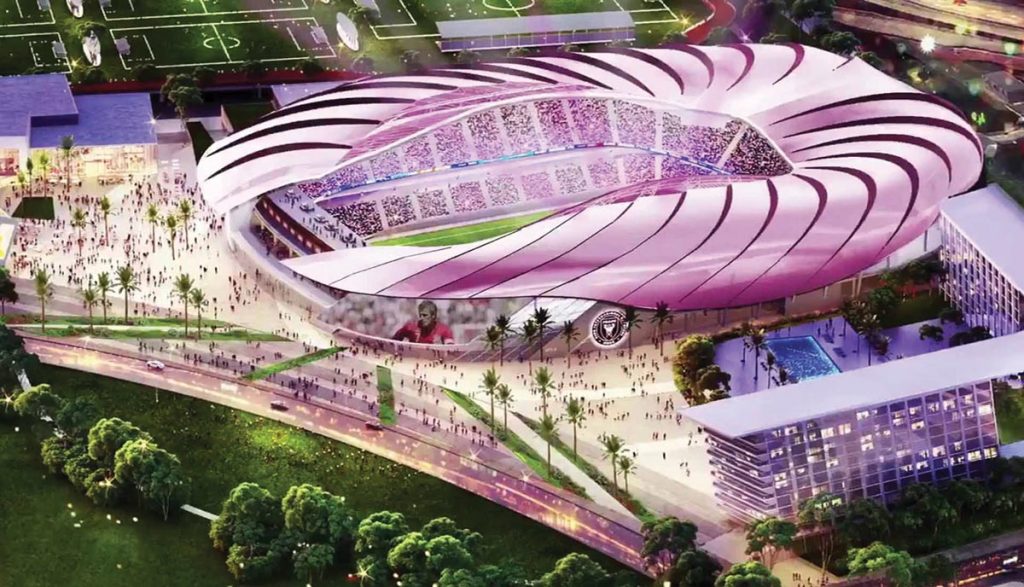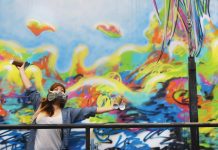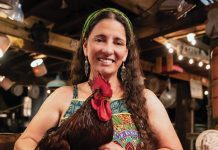
There may be a day, in the very near future, when all of us will know the names of the entire starting squad of Miami’s professional soccer club.
That club is called Club Internacional de Fútbol Miami, or Inter Miami CF (IMCF) for short. The Herons are currently in their third season, and the plan is to become South Florida’s team. Forget your love-hate relationship with the Dolphins. Prepare to replace the Heat as your favorite crew to root for. You will—IMCF ownership hopes—someday bleed black and pink.
If you, like many Americans, think soccer will always be a sport that just can’t catch on here, consider telling that to David Beckham. In case you haven’t heard, Beckham (who is arguably England’s most famous former professional footballer) is one of the owners of IMCF.

Even though his team took almost a decade to get off the ground and despite a couple lackluster first years, Beckham and the IMCF squad he has assembled have a united front of optimism. This will be the year, they say. Soccer has arrived, they promise.
Could it finally be true?
“We are committed to developing talent here in South Florida and that remains a key focus for us,” Beckham said via email.
The potential for IMCF, of course, is limitless—which has also been true throughout the entire history of soccer here in South Florida.

Pro soccer arrived in town in 1973, when the Washington Darts relocated here and became first the Gatos and then later the Toros. Even landing in the championship game in 1974 couldn’t bring fans to Toros games. Things looked better after a move to Fort Lauderdale, where the team became the Strikers and started to fill Lockhart Stadium. The first Strikers team ended up relocating to Minnesota (of all places), later replaced by a new version of the Strikers that didn’t have the same draw as the original.
Major League Soccer arrived in 1998 with the Miami Fusion, under the assumption that the metro’s large Latin population would fill the seats. Like the someday-soon renewable energy the team was named after, the Fusion never seemed to catch on, and the team folded after its 2001 season.
A new team called Miami FC sprung up in 2006 and also moved to Fort Lauderdale to become a third version of the Strikers. Despite a loyal following and success in the North American Soccer League, the team faded away in 2016.

At the same time as the third iteration of the Strikers was fizzling out, Beckham began trying to bring the MLS back to Miami. After he retired from professional soccer in 2013, Beckham started a back-and-forth negotiation with Miami-Dade to build a stadium. Beckham’s personal star power notwithstanding, the MLS took five years to approve his plan for his own franchise. He’s still waiting for his Miami stadium. Miami Freedom Park remains under construction, a $1 billion project that’ll seat 25,000 fans out by the airport when it opens in 2025.
Meanwhile, the team has begun its third season in Fort Lauderdale, where the stadium is now called DRV PNK Stadium and includes a training center and seven additional fields for the team and Fort Lauderdale CF, the team’s practice squad. Fort Lauderdale’s stadium is also home to IMCF Academy, a youth training program that funds six teams across age groups from U12 through U17. Academy players train and work their way through the ranks toward the MLS, similar to the way in which European soccer clubs groom young talent.

The Herons’ 2022 season started off rocky. The team’s first game—at home, against Chicago—ended in a zero-zero draw. By July, the team had won just six out of 17 games, putting it in ninth place out of 14 teams in the MLS. But the team announced a major trade when the Herons cut a $150,000 check to Toronto FC and received Landon Donovan, the league’s MVP. Afterward, trade publication Soccer America said that “one of the most poorly constructed teams” finally had gained momentum.
In his email, Beckham had a lot of optimism for the team’s future: “I cannot wait to bring a new stadium to Miami for our fans to enjoy—Miami Freedom Park will be one of the best soccer stadiums in North America and will rival the greatest in global football.”

Beckham’s partner in IMCF is billionaire Jorge Mas, the largest shareholder of MasTec, the construction and engineering company founded by his father. By email, Mas said the soccer team is a culmination of what his family has been working toward for all these years. “When my parents left Cuba fleeing tyranny, South Florida welcomed them with open arms,” Mas wrote. “It is our home, the place where my brothers and I were born. The place where I received an education, got married, and raised my family. To be able to bring professional soccer to a community that has given so much to me is a dream come true.”
Along with the new stadium and the Herons competing in their third season, Miami will also host the World Cup in 2026. Mas promises that “South Florida will further emerge as the soccer epicenter of the United States.”
It’s quite possible that South Florida will finally get behind a soccer team, according to CBS Sports’ Andres Cordero. Born in Cuba, Cordero has been in Miami since he was 8 years old, and he’s worked as a soccer commentator here since 2003. “I’ve grown up with Miami soccer culture before there was an MLS team,” Cordero says. “Finally getting a professional team was a big deal for me personally.”

This third year for IMCF looks to be the best of them, Cordero adds. There’s a consistent core of around 12,000 fans—known as La Familia—who come to every game and have stuck with the Herons since the beginning. A few of them even travel to away games. Cordero remembers one game during the pandemic lockdown when fans weren’t allowed in the stadium, and yet hundreds of them showed up, in the rain, to cheer from the parking lot.
Cordero admits that people have been saying for decades now that soccer will be big here, but he believes this could finally be the day: “Miami has been really hungry for soccer for a long time.”
Is it now, then, that soccer will become a thing in South Florida? Perhaps for soccer it’ll always be tomorrow. Or perhaps tomorrow has finally arrived.

On the Mark
Know your team trademarks
Mas and Beckham turned to designer Kimou Meyer at Doubleday & Cartwright to create the team’s visual identity. “I knew that creatively he would come up with something different,” Beckham explains in a team video. Meyer studied Miami’s architecture to make IMCF stand out in style.
The Mascot: Chosen for its loyalty to South Florida (it does not migrate) and its quick strike when hunting prey, the Great White Heron was an obvious mascot for the team.
The Crest: The crest’s central image depicts a pair of herons, their legs intertwined to form an Old World–style monogrammed “M,” while an eclipse of the sun floats between their heads.
The Colors: Representing Miami sunrises, pink was a front-runner from the get-go. “If there’s one city in the world that can own pink,” Meyer says, “it’s Miami.” Black was the obvious counterpoint.
The Motto: “Libertad, Unidad, Fortuna” pays tribute to freedom, unity, solidarity, inclusiveness, opportunity, and good fortune for all. —Kristen Desmond LeFevre

Q&A: Learning to Get Back Up
The coach of Miami’s pro soccer team says the key to surviving tough times is to “stay true to who you are”
Inter Miami CF brought in Phil Neville to coach the team before the 2021 season, hoping Beckham’s former teammate at the storied Manchester United could help bring early success to the second-year franchise. But while the team won just 17 of its 34 matches in the MLS that year, Neville says what he learned from his time as a player—in success but especially in failure—helped him navigate those rough waters.
AVM: As a player for Manchester United and Everton, you helped win the Premier League six times. How has that experience helped you as a coach?
Neville: People all the time want to talk about the great things—the trophies, the medals, the cups. But I really think the down moments were equally as powerful. The down moments were [when] I learned more about myself and probably more about situations you find yourselves in as a coach, how you deal with players, how you deal with certain situations. You’re not taught how to deal with a player who’s lost a family member, or a player who’s got a mental illness. I’ve coached people with disabilities, women, girls, boys, men. So, I’ve gained a lot of experience in my short life, so far, that [has] taught me how to be a coach.

Is there one of those difficult moments that you really learned from?
There were a couple moments that took me to places that really tested me, mentally. Talking about coaching, a lot of it is mental, about having consistency. As a player, there were two or three incidents. The biggest one was when I was 19 or 20, in 1997. In England, we have a tradition of playing on December 26. We drove down to Nottingham on Christmas night, and I started to have flu-like symptoms—cough, cold, shivers. The next morning, I couldn’t physically get out of bed. I couldn’t play in the game, and I ended up having a virus called glandular fever, which saps all your energy and your muscle strength. I was 11-stone-10 [164 pounds], and I went to 11-stone-two [156 pounds] in the space of three weeks. My career was in doubt. It was going to take a lot of rehabilitation when I came back. I was a first-team player for England, and for the next 12 months—I look back at pictures—I was literally just a shadow of myself. It took me three years to get back up to 11-stone-10. My career flashed before me, and that was quite a scary experience.
 You had a tough first year in Miami. Did it give you the perspective to say, “Okay, let’s go at it again next year?”
You had a tough first year in Miami. Did it give you the perspective to say, “Okay, let’s go at it again next year?”
The challenges that I’ve had in my playing career help build durability. And durability means that in life you know you’re going to get up-and-down
moments. And in the down moments, you’ve got to stay true to who you are, stay true to the values and culture you want. And that’s what happened last year. I started with a certain way of working, a certain way of coaching, a certain way of behaving. The darkest moments are when you’re going to be tested, and that’s a challenge for any person. When the going gets tough is when you see the true characteristics and personality of the person.
You’ve talked about wanting to build a young team. How is it coming together?
I think that’s going to be one of the foundations of this football club, to produce our own players. That’s something that David [Beckham] in particular is so passionate about. We’ve already given opportunities to some of our Academy players, which was a great boost for our academy, that they know that the work that they’re doing is being rewarded. We’ve got a great group of young players who will need time and patience, but they’re going to get an opportunity because there’s a pathway for success. They have a fearlessness about themselves, and I relate to back when I was young and somebody had to give me an opportunity. And now I’m in a position where we can produce some players and give them opportunities in the MLS.
Outside of sport, what does your life in South Florida look like these days?
I live in Fort Lauderdale. When I first got to town, I lived…in an apartment on Las Olas, and I think Las Olas is a vibrant, exciting, interesting place. When I want to switch off from football, I go down there with my wife and the children sometimes. —E. B.

Join the Club
There are fans, and then there are super fans. For IMCF supporters who fall into the latter category, there’s La Familia, the collective body that cheers from the north stands on match days at DRV PNK Stadium. Amid plumes of pink smoke, flying streamers, waving banners, trumpet fanfares, drumbeats, and chants, three distinct groups—Vice City (hailing as the “hardcore” faction with Latin American flair and traditions), Southern Legion (known as the first and original group), and The Siege (billed as ultra-inclusive and community-minded)—come together to bring the passion, noise, and fun as they cheer on IMCF and create a next-level fan experience in the process. —K.D.L.
Kicking It
Four Inter Miami CF players to watch
The Star
Player: DeAndre Yedlin
Age: 28
Hometown: Seattle, Washington
Number: 2
Position: Defender, Full Back
Yedlin made his debut for IMCF in the 2022 season opener, and has since gone on to play more than 900 minutes and record three assists, one of which set up the game-winning goal against the Seattle Sounders. Yedlin also captained IMCF twice, including a match against Atlanta United FC, leading by example and setting up the first goal in a 2-1 victory.
“I want to win everything with the club. If that’s not your goal as a player then you’re not in it for the right reasons,” Yedlin says. “This club [has] international attention, so it’s important that the club wins and consistently does well. That’s what I want to help this club achieve. I want to win championships, I want to win U.S. Open Cups, I want to win Champions Leagues. That’s the main focus: to win, to keep improving, to help the younger guys, and to keep pushing forward.”

The Midfielder
Player: Jean Mota
Age: 28
Hometown: São Paulo, Brazil
Number: 7
Position: Central Midfielder
Jean Mota bolsters IMCF’s roster following a nearly 10-year-long career in Brazil and other prestigious South American club competitions. Mota is already setting lofty ambitions for his time in South Florida and is looking forward to achieving great things with IMCF.
“Inter Miami is a big club, and it’s a team that deserves to be in the playoffs, going for the trophy,” he says. “On the field, I’m a player [who] gives it all. I think about the whole team and not just myself. I’m a professional, always looking for the best for the club. A lot of people don’t know me yet, but I’ll be working to showcase everything I have built in my career so far. I’ve had great moments, and I’m looking forward to creating more great ones in an Inter Miami jersey.”

The Keeper
Player: Nick Marsman
Age: 31
Hometown: Zwolle, Netherlands
Number: 21
Position: Goalkeeper
The Dutch goalkeeper joined IMCF in July following two years with Feyenoord Rotterdam in the Eredivisie, the first division in the Netherlands. Marsman also gained valuable experience by competing in the UEFA Europa League during his time plying his trade in his home country. “The team has a whole plan to grow, a lot of ambition,” he says. “I just feel like I want to be a part of this, a part of this project.”
IMCF’s front office is thrilled to have Marsman on the team roster. “We are pleased to welcome Nick to Inter Miami,” says Chris Henderson, IMCF’s chief soccer officer and sporting director. “He brings a wealth of qualities, both in and out of possession, which will impact and complement our style of play.”

The Hometown Kid
Player: Noah Allen
Age: 18
Hometown: Fort Lauderdale, Florida
Number: 32
Position: Defender
Signed to the team in March, Allen is the first IMCF Academy alumnus to start an MLS match and just the second to feature for the First Team. The moment he stepped onto the field in IMCF colors for the first time is one he says will stick with him.
“I know Coach Phil [Neville] said that I didn’t look that nervous, but I definitely was nervous,” Allen says. “It was just a beautiful moment, walking out, and when I looked over to La Familia, it was crazy. It was like a swarm of people; I couldn’t really grasp that moment, but it was just beautiful. Obviously, the standing ovation going off was another beautiful moment that I’ll never forget.”
As a member of the club’s inaugural Academy class, Allen has been with IMCF from the very beginning, but his support for the club even predates its official start. “[Signing for this club] means everything. It’s been a dream of mine and my parents since we first saw on the news, ‘David Beckham bringing a professional MLS team to Miami’ years and years ago. I remember waiting so long for this club to be built and the Academy to be brought up. I remember the invitation to join the Academy, so it’s just a dream come true.” —K.D.L.

Play On
Where Does the Home Team Call Home?
 Miami: Freedom Park Approved by the Miami City Commission in April, IMCF will move to Miami Freedom Park for the 2025 MLS season. The airport-area complex (which currently contains Melreese golf course) will include a new state-of-the-art stadium that will seat 25,000 fans, surrounded by 58 acres of public parks and green space, a tech hub, restaurants, shops, community sports fields, and more. “[It’s] an amazing day for the voters of our city, for the fans of football in Inter Miami,” Mas said in a press conference after the approval was confirmed. “I always knew that this would happen, because I believe in our city and I believe in dreaming. And today a dream commences.”
Miami: Freedom Park Approved by the Miami City Commission in April, IMCF will move to Miami Freedom Park for the 2025 MLS season. The airport-area complex (which currently contains Melreese golf course) will include a new state-of-the-art stadium that will seat 25,000 fans, surrounded by 58 acres of public parks and green space, a tech hub, restaurants, shops, community sports fields, and more. “[It’s] an amazing day for the voters of our city, for the fans of football in Inter Miami,” Mas said in a press conference after the approval was confirmed. “I always knew that this would happen, because I believe in our city and I believe in dreaming. And today a dream commences.”
 Fort Lauderdale: DRV PINK Stadium IMCF plays and trains at its 34-acre facility—including the 19,100-seat DRV PNK Stadium, a 50,000-square-foot training center, and seven fields in Fort Lauderdale. At this location, IMCF also fields the MLS NEXT Pro team Inter Miami CF II, as well as a youth Academy. —K.D.L.
Fort Lauderdale: DRV PINK Stadium IMCF plays and trains at its 34-acre facility—including the 19,100-seat DRV PNK Stadium, a 50,000-square-foot training center, and seven fields in Fort Lauderdale. At this location, IMCF also fields the MLS NEXT Pro team Inter Miami CF II, as well as a youth Academy. —K.D.L.











Facebook Comments